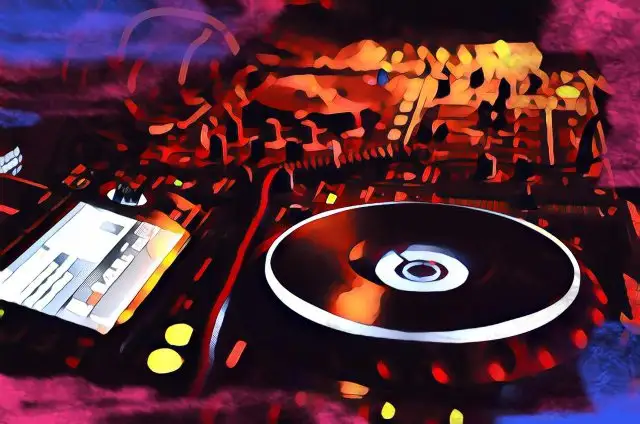Nowadays, EDM is everywhere.
You hear it at the largest music festivals like Electric Daisy Carnival or Tomorrowland, at your favorite local bar, at house parties, and on most radio stations. Almost a quarter of the music on Spotify is labeled as EDM, and 23% of listeners aged between 16 and 19 listen to it.
The funny thing is, EDM is not even a genre! It’s an umbrella term that includes a variety of styles so different from each other that some barely have anything in common.
Nevertheless, starting from the early 2010s, the EDM revolution has changed the dance culture and pop music for good, skyrocketing the good-old electronic music into the realm of mainstream, and shining a light on the vibrant ecosystem of DJs and clubs pushing the boundaries of this new movement.
Today, we’ll analyze what EDM is, how it started and where it’s heading, and define its most popular subgenres. We’ll end the article with a section on how you can make EDM using your DAW (digital audio workstation), so if that’s what you’re looking for, you can jump straight to the Getting Started with EDM Production section.
A Definition of EDM
EDM stands for Electronic Dance Music, and that pretty much explains what this umbrella term refers to: it’s music made with electronically synthesized instruments that are designed to make people dance through catchy rhythms and melodies.
Electronic instruments can be both analog and digital, and so can the audio processes of sampling and audio editing. What’s important to remember is that the term “EDM” includes everything that’s made to dance with.
Electronic music, an even wider umbrella term, includes music genres like electroacoustic, drone, and ambient music, which are not danceable genres but are still made via electronic means, or a combination of analog and electronic elements.
Back to EDM. Given the variety of genres that fall within this category, it’s hard to find common elements between all of them, but here are some:
- They all have a rhythmic pulse, in a tempo that could be anywhere between 60 BPM (Dub) to 180 or more (Drum and Bass).
- Songs tend to be easy to listen to and memorable, with catchy melodies and an energizing vibe.
- Plenty of effects and processing are applied to all instruments and voices.
- Frequent use of samples and pre-recorded materials.
- It’s music designed to galvanize listeners when played at festivals and parties.
Everything else is optional, and every genre has its own sound signature that separates it from the others, which is what makes EDM such a vibrant and creative ecosystem for producers.
A Timeline of EDM
Believe it or not, EDM has its roots in Musique Concrète, a form of music composition that started in the 1920s and is based on mixing and modifying pre-recorded sounds.
This was the time when composers first attempted to create music using multi-layered sounds and blending them to create a coherent soundscape. A great example of this art form is John Cage’s body of work.
As technology evolved, so did electronic experimentation. More powerful electronic generators led to the birth of Elektronische Musik in 1950s Germany, a pure-electronic-music movement led by the great Karlheinz Stockhausen.
(Germany became a phenomenal melting pot of electronic experimentation, bringing to life unique electronic genres for decades, from Kosmische Musik to Electropop and Berlin Techno. To this day, Berlin is one of the unmissable music destinations for EDM enthusiasts.)
In the late 1960s and throughout the 1970s, the rise in popularity of modular synthesizers (Robert Moog’s first commercial synthesizer was released in 1964) and drum machines resulted in a wider exploration of electronic sounds.
Disco music, with its four-on-the-floor beats and addictive basslines, is a precursor of modern EDM and has reached worldwide success with Giorgio Moroder and Donna Summer. Electropop, with Kraftwerk and the Yellow Magic Orchestra as its most popular acts, also achieved global success by the mid-1970s.
It’s also crucial to mention the impact of dub music and sound system culture that originated in Jamaica around this time, which ignited the remix culture and enhanced the use of DJ decks and mixing boards as creative instruments.
In the early 1980s, all these elements converged and blended in two cities, Chicago and Detroit, which gave birth to House and Techno music, respectively.
Chicago House music is disco revisited in a more electronic form, with 4/4 rhythms made with drum machines, accessible melodies, deep basslines, and enhanced syncopation.
Detroit Techno music is more futuristic, with heavier beats and a more abstract vibe than House. It also tends to have more complex percussive rhythms.
From the 90s, new ramifications in the Electronic Music ecosystem started to emerge everywhere around the world.
For years, trance music became the driving force of mainstream electronic music, while more rave-oriented genres like jungle and Drum and Bass became popular in the UK and European club culture. The French duo Daft Punk brought to life a unique blend of electronic, dance, and disco music that turned them into a global phenomenon.
In the 21st century, the popularization of DAWs revolutionized electronic music production, allowing countless artists to experiment with music production even without having access to high-end music equipment or recording studios.
This leads us to the next chapter: the most popular EDM genres now.
An Overview of EDM Genres
There are endless genres and subgenres falling within the EDM category, and analyzing each one of them is beyond the scope of this article. However, it’s important to understand the differences between the most popular EDM styles, and how you should approach production depending on the genre you want to focus on.
In this section, you'll find a list of some of the most popular electronic dance music genres from the past and present, in alphabetical order. To keep things simple and tidy, for each genre I outlined the main sonic characteristics, the usual tempo, and the most popular artists that defined the genre.
Acid Techno
From the late 1980s, and throughout the 90s, Acid Techno was a big thing in raves and underground clubs. It was inspired by the otherworldly sounds of the Roland TB-303 synthesizer, and features repetitive beats, minimalistic textures, and a tempo around 140 BPM. Check out Aphex Twin, Richie Hawtin, and Chris Liberator to get an idea.
Bass
Bass Music is a wide style that includes genres like Dubstep, Drum and Bass, Trap, and basically anything that has a powerful low end. Bass music usually has heavy basslines that drew inspiration from the UK soundsystem and garage culture. Skream and Benga are pioneers of the genre.
Big Room House
The epitome of a festival-friendly sound, Big Room House is the biggest EDM genre right now in the club scene. It became popular in the early 2010s, with Martin Garrix, Hardwell, Nicky Romero, and Afrojack quickly becoming the top representatives of the genre. As a style, it’s very easy to identify: massive drops, simple melodies, and a tempo of around 128 BPM.
Bitpop
Blending chiptune elements with pop music, Bitpop is a genre of electronic music that uses the sound chips of older (8-bit or 16-bit) computers and combines them with modern equipment and vocals. It has a nostalgic vibe, with a tempo ranging from 100 to 140 BPM. Listen to Anamanaguchi and Slagsmålsklubben.
Breakbeat Hardcore
Breakbeat Hardcore combines breakbeat rhythms with the galvanizing feel of rave music. It emerged in the 90s in the UK and usually features fast tempos around 145–155 BPM or higher, heavy bass, and sampled vocal hooks. The Prodigy, especially their early albums, are the best examples of this style.
Deep House
Deep House has an immersive vibe with catchy basslines, percussive elements, jazzy chords, and a tempo of around 120-125 BPM. Duke Dumont, Robin Schulz, and Maya Jane Coles are all great artists you should check out if you’re interested in the genre.
Deep Techno
As opposed to Deep House, Deep Techno has richer textures and a more hypnotic flow. It has a steady tempo of roughly 120-125 BPM and often includes ambient soundscapes. Donato Dozzy and Deepchord are the best in the game, in my opinion.
Downtempo
Downtempo blends elements of ambient and chillout music to create a relaxing atmosphere. It usually has a slow tempo of 60-90 BPM to enhance the soothing, introspective atmosphere the genre conveys. Check out Bonobo to get an idea.
Drum and Bass
Drum and Bass started in the UK in the early 1990s and is experiencing a great comeback these days. It has a tempo of around 160-180 BPM, features fast breakbeats, cavernous basslines, and intricate rhythms inspired by jazz drumming on steroids. I’d recommend listening to Chase & Status, Pendulum, Sub Focus, Goldie, and Noisia.
Dub Techno
Dub Techno has a deep sound that encourages introspection, and an engaging dub vibe that makes it a staple in underground clubs globally. It has a tempo ranging between 110 and 120 BPM. Artists like Basic Channel and Deepchord are pioneers of the genre.
Dubstep
Dubstep was the genre of the mid-2000s, with its heavy bass drops and syncopated rhythms that influenced every other mainstream genre, from heavy metal to pop. It has a tempo of around 140 BPM and a dark, brooding atmosphere. The genre can be quite diverse, but there’s no doubt Burial has created a sound signature that defined the genre, so check out his discography if you want to find out more about the style.
Electro House
Electro House became popular in the early 2000s, with a blend of house music and electro-inspired sounds, heavy basslines, and a tempo ranging between 125 and 135 BPM. Deadmau5 and David Guetta made the genre mainstream back in the day.
Electro Swing
An interesting fusion of vintage swing music and modern electronic beats, Electro Swing offers quite a unique approach to modern EDM, with up-tempo rhythms around 110-130 BPM and heavy use of brass samples. Check out Parov Stelar and his immense production to experience the genre at its finest.
Future Bass
Future Bass has a warmer vibe and more uplifting sound than the genres it’s inspired by, mostly dubstep and trap. It became popular in the mid-2010s, with a tempo ranging anywhere between 130 and 175 BPM. Flume and Illenium popularized the genre over the last decade, although Future Bass seems to have lost momentum in the 2020s.
Glitch
Glitch music uses digital distortion, glitches, and unexpected sounds to create an experimental soundscape, usually accompanied by an electronic-inspired beat. Artists like Autechre, Apparat, and Tim Hecker are all great representatives of the genre.
Hardstyle
Highly popular in the Netherlands, Belgium, and Italy, Hardstyle is a hard-hitting, in-your-face genre with distorted kicks and galvanizing melodies. The tempo usually gravitates around 140-150 BPM. Headhunterz and Showtek have performed the genre in the most famous festivals worldwide.
Industrial
Industrial music can be extremely diverse, ranging between ambient and metal music and anything in between, but you’ll always find a dystopian feel that somehow connects the genre in all its variations. Nine Inch Nails and Front 242 are some of the genre’s best-known exponents.
Lo-Fi
Low sound quality, soft beats, ambient noise, and a laid-back tempo of around 60-90 BPM is the successful formula of lo-fi, a genre that’s become extremely popular over the last decade, especially because it’s perfect for studying and relaxation. Artists like Nujabes and Jinsang have pioneered this genre with their soothing, nostalgic tracks.
Minimal Techno
Minimal Techno is a stripped-down version of Techno, with repetitive beats, minimalistic elements, and a tempo between 120 and 130 BPM, that became popular in the early 1990s. Richie Hawtin, Robert Hood, Ricardo Villalobos, and Mika Vainio are some of the biggest producers who explored this hypnotic genre.
Progressive House
Progressive House is a trance-inspired style of House music with melodic structures, euphoric drops and a tempo usually around 125-130 BPM. However, it also shows a more complex structure when compared to uplifting trance, with intricate rhythmic layers or melodic patterns. Check out Eric Prydz, deadmau5, Swedish House Mafia, and Lane 8.
Trance
Trance music is pure euphoria translated into sounds. With immersive melodies, and an engaging tempo (up to 150 BPM) with exhilarating build-up and releases, the genre became popular in the 90s and has never left the dance floor since. I’d recommend you start exploring the genre from the masters: Armin van Buuren, Paul van Dyk and Tiesto.
UK Garage
UK Garage started in the 1990s in the UK as a blend of syncopated, 2-step rhythms with dance and R&B elements. Largely inspired by the jungle movement but more accessible to casual listeners, the genre quickly grew in popularity worldwide, branching off into a plethora of subgenres, from bassline, future garage, grime, and dubstep. El-b and Groove Chronicles are among the best artists exploring the genre.
Vaporwave
Vaporwave is a fascinating microgenre that combines retro aesthetics with a surreal feel. It usually features slowed-down samples, with a tempo of around 60-90 BPM, reminiscent of the 80s and 90s pop culture, as well as music for commercials and elevator music from bygone eras. Over the years, the genre has been used as a tool to expose (and criticize) the modern techno-culture. If you’re interested in this hidden corner of EDM, make sure you check out Telepath and Saint Pepsi.
Getting Started with EDM Production
Your first track might not sound like a global hit, but taking your first steps in the world of EDM music production is not that difficult. There are certain software and plugins you need, but after that, all you have to do is practice, practice, and practice!
Below you’ll find what I think is the best approach when making EDM music. Every genre is different, but as far as I know, this is a structure that works well with all the styles that fall within the Electronic Dance Music Category.
Choose your DAW
We could spend days talking about which DAW you should go for, but let’s try to keep it simple.
Most, if not all, professional DAWs would meet your needs as an EDM producer, especially if you’re a beginner. If GarageBand is all you have or can afford (it’s free), then use it. If you don’t use Apple products, go for Cakewalk (again, free, but for Windows).
If you can invest a bit more and want to learn how to produce tracks professionally, there are two exceptional DAWs for EDM producers I’d recommend: Ableton Live and FL Studio.
Ableton Live is the most popular DAW, and it’s phenomenal when it comes to EDM production, thanks to its iconic looping system. FL Studio is another great option for electronic music producers, with a professional sound library and super intuitive drum machine and MIDI keyboard.
That said, whichever DAW you happen to have available should have enough tools and sounds to create a basic EDM track. As you'll see below, I don't use either Ableton Live or FL Studio, but I can still create an EDM track from scratch. So don't focus on the tool too much, but rather focus on how you can create the perfect EDM production workflow on your DAW of choice.
Once again, any DAW can be good, so long as you’re familiar with how it works. Take your time to test out a few different workstations (most of them are available on free trial), and see which one best suits your workflow.
Before we start, let me clarify that there's no golden rule in electronic music production. Plus, the workflow between hip-hop and techno producers, for instance, can be dramatically different.
This is to say that I hope you'll find value in the workflow presented below, but you might have a completely different approach to music production and still release exceptional music.
Tempo and Drumbeat
The drumbeat is the thing you want to start with, and four-on-the-floor is the way to go.
Choose the speed of your track based on the genre you’re working on. If you’re producing a classic dance or tech-house song, choose anything between 126 and 132 BPM.
For this guide, I’ll use Studio One as DAW:
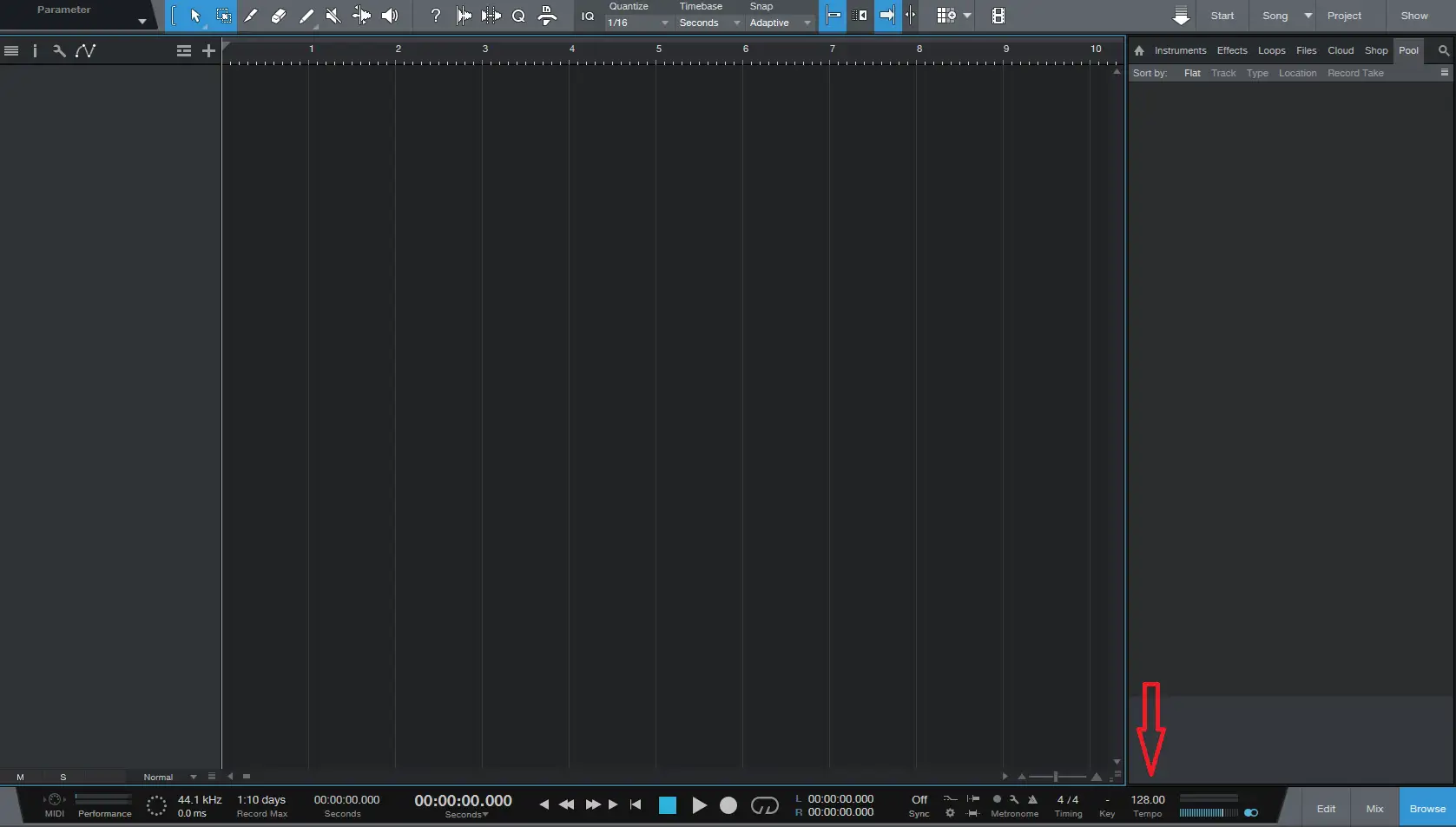
Setting your project at the right tempo before getting started is important for various reasons, but mostly because you want to hear how your samples sound at the speed the track will be finalized. You might have a vocal sample that sounds great at 126 BPM but extremely artificial at 132 BPM, so choose the tempo wisely, and make sure you pick the right samples for your track.
Next, focus on the kick, which is the foundation of your EDM track. On your DAW, add a new mono track, choose a kick drum sound you like from your library (most DAWs come with some built-in library, and if yours doesn’t, there are plenty of free libraries online.)
Next, copy/paste your kick drum sound on your new track, and add a kick to every beat of the first measure. Then simply highlight the whole section, and duplicate for as long as you’d like your track to be.
If done correctly, your EDM track should now look like this:
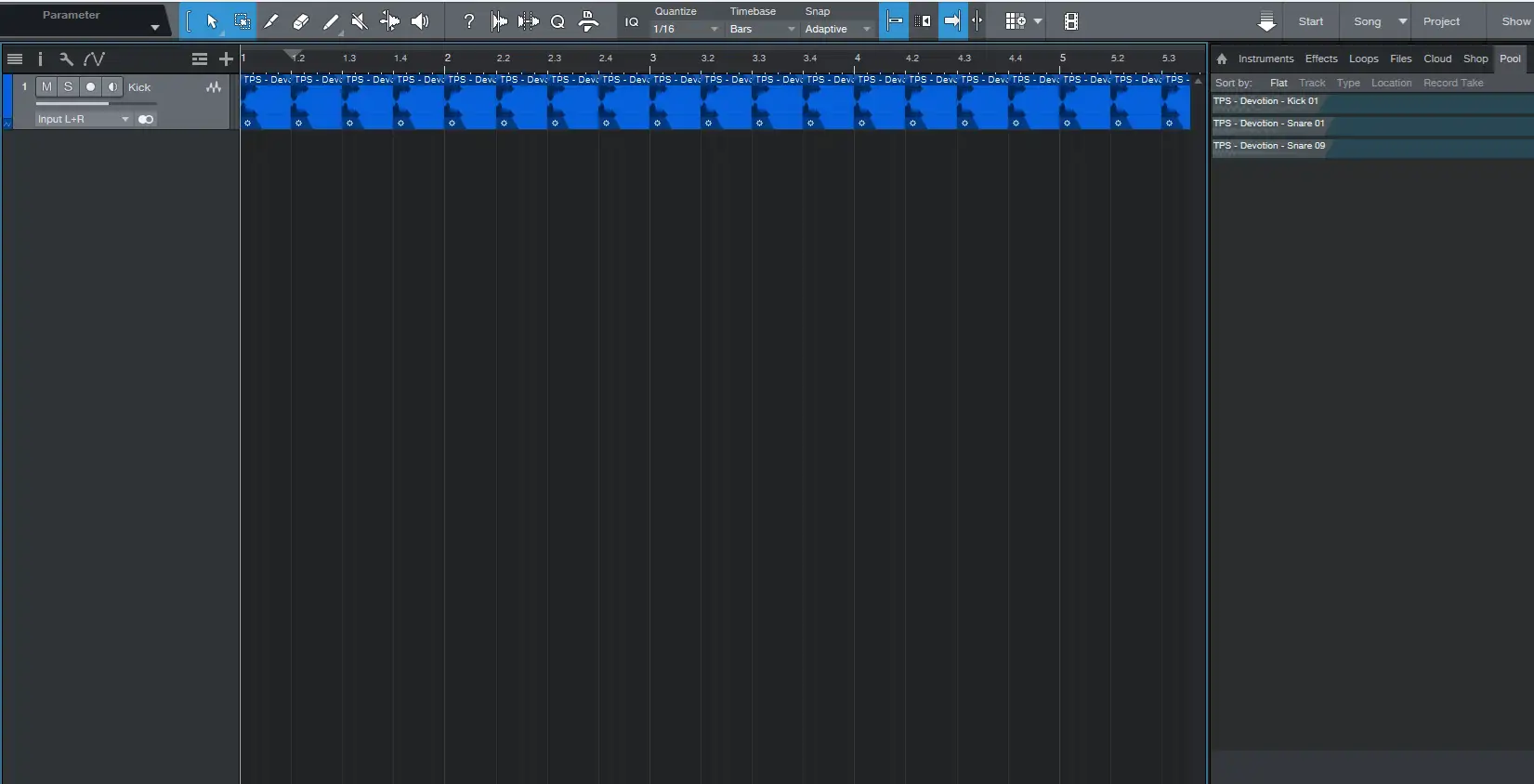
DAWs like the aforementioned Ableton Live and FL Studio come with intuitive looping systems and piano rolls that make beat-making a walk in the park. But in general, if you get the tempo right and add a kick drum to all the beats, you should hear the familiar pumping dance sound.
Now, let’s focus on the snare drum, which is what drives your song forward.
EDM snares usually play along with the kick drum on the quarter notes, or they play faster rhythms as they lead up to the drop section. Here’s an example of how a basic drum/snare beat looks like:
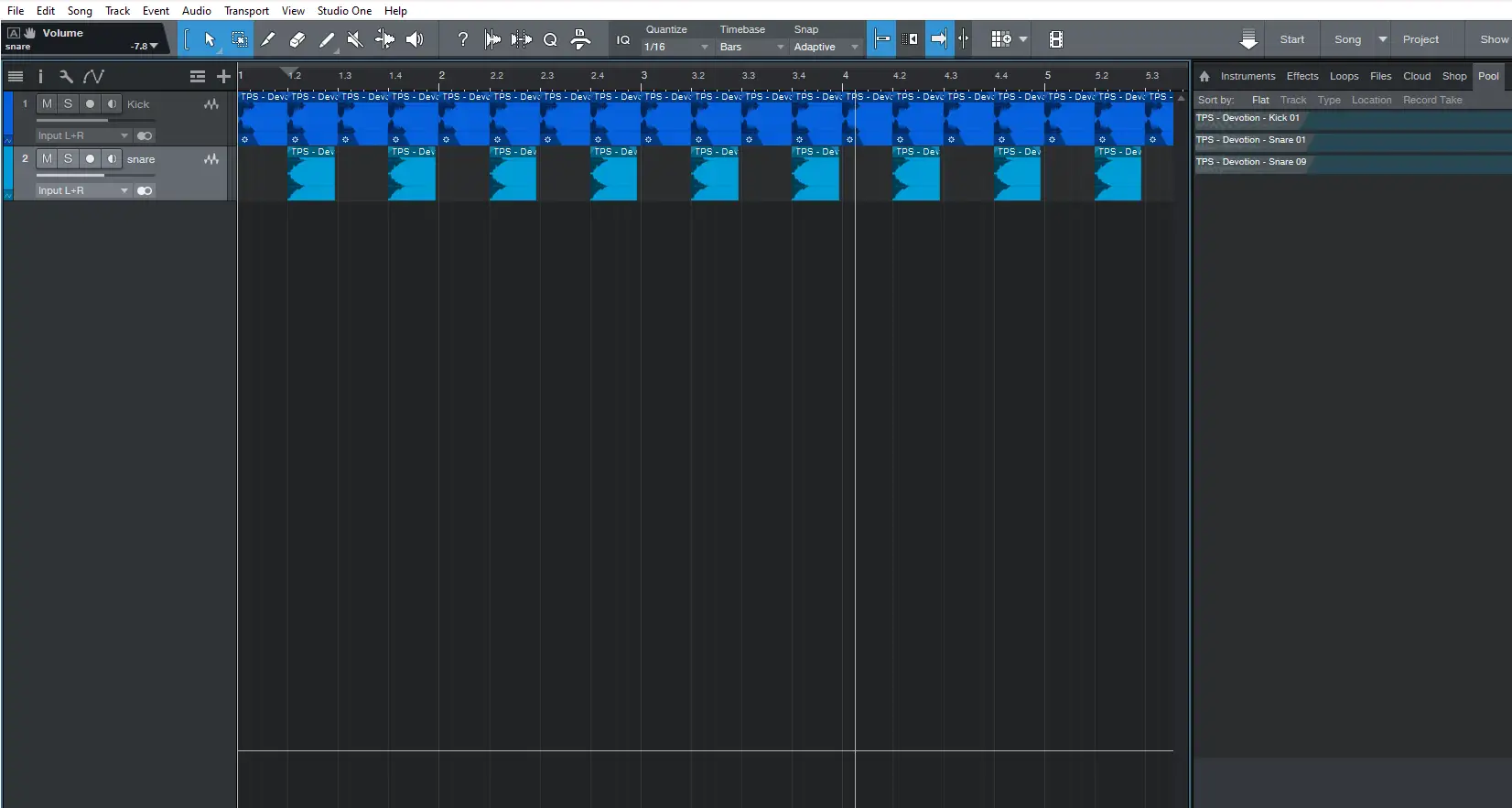
EDM songs come in many shapes and forms, and not all club music is four-on-the-floor. Yet this is a great starting point if you're creating your first EDM tune.
If you're using samples, make sure the beats are perfectly synchronized and check the volume levels when the kick and snare drum play simultaneously. It's easy to get a distorted sound as most EDM sounds are designed to be as loud as possible.
Bassline
Even if you already have a melody in mind, it’s always good practice to start from the bassline, as it’ll be the bridge between the chords and rhythms that’ll define your song.
I’d recommend you keep it simple at first. You can always make it more articulated later in the process, but for now, create something that’s groovy and catchy.
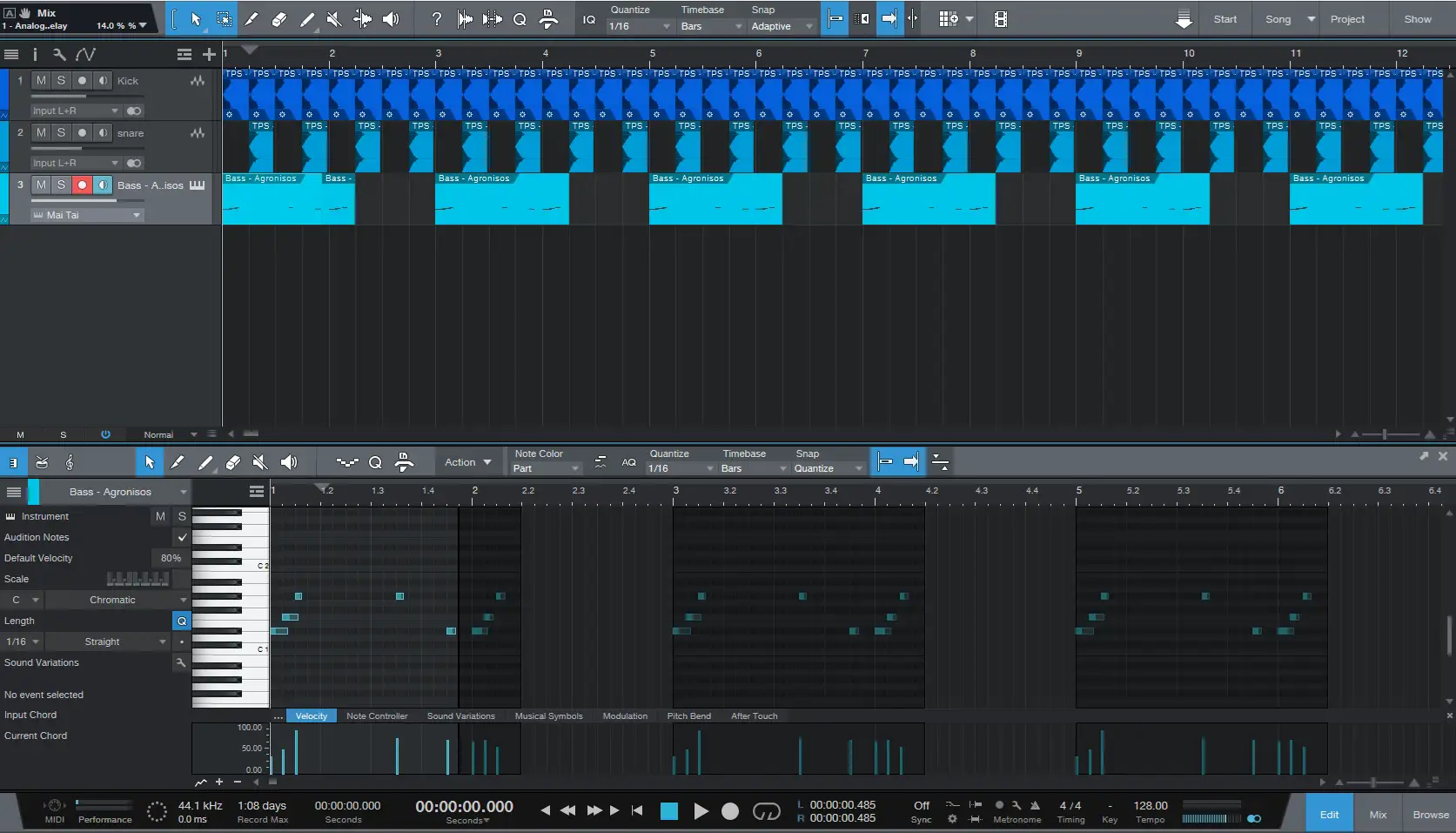
When it comes to the bass, it's important to find the perfect balance between groove and subtlety. In some genres, like minimal techno, the bass might be the main element of your song, but in general, it should be the glue between rhythm and melody, adding depth to both without overshadowing them.
Hi Hat and Crash Cymbals
The iconic audio engineer Steve Albini called the hi-hat a “truly satanic instrument” because it seems to always be on the way when recording drums. That might be the case in indie rock music, but when it comes to EDM, the carefully crafted hi-hat section is often what makes a track galvanizing.
Use a combination of closed and open hi-hat sounds that’ll fill the rhythmic section with high-pitched elements, making sure the hi-hat complements the existing beat and enhances the groove.
Some tracks work well with minimal hi-hat, while others feel more complete when the hi-hat is a constant presence. Unlike with kick and snare drums, you can get endlessly creative with the hi-hat.
There's no one-size-fits-all solution when it comes to the hi-hat. The only thing to keep in mind is that it should follow the rhythm of all the other elements of your song and add variety to the drums through accents and groovy effects.
For this example, I used a drumloop I created for a previous track, but you should get the idea:
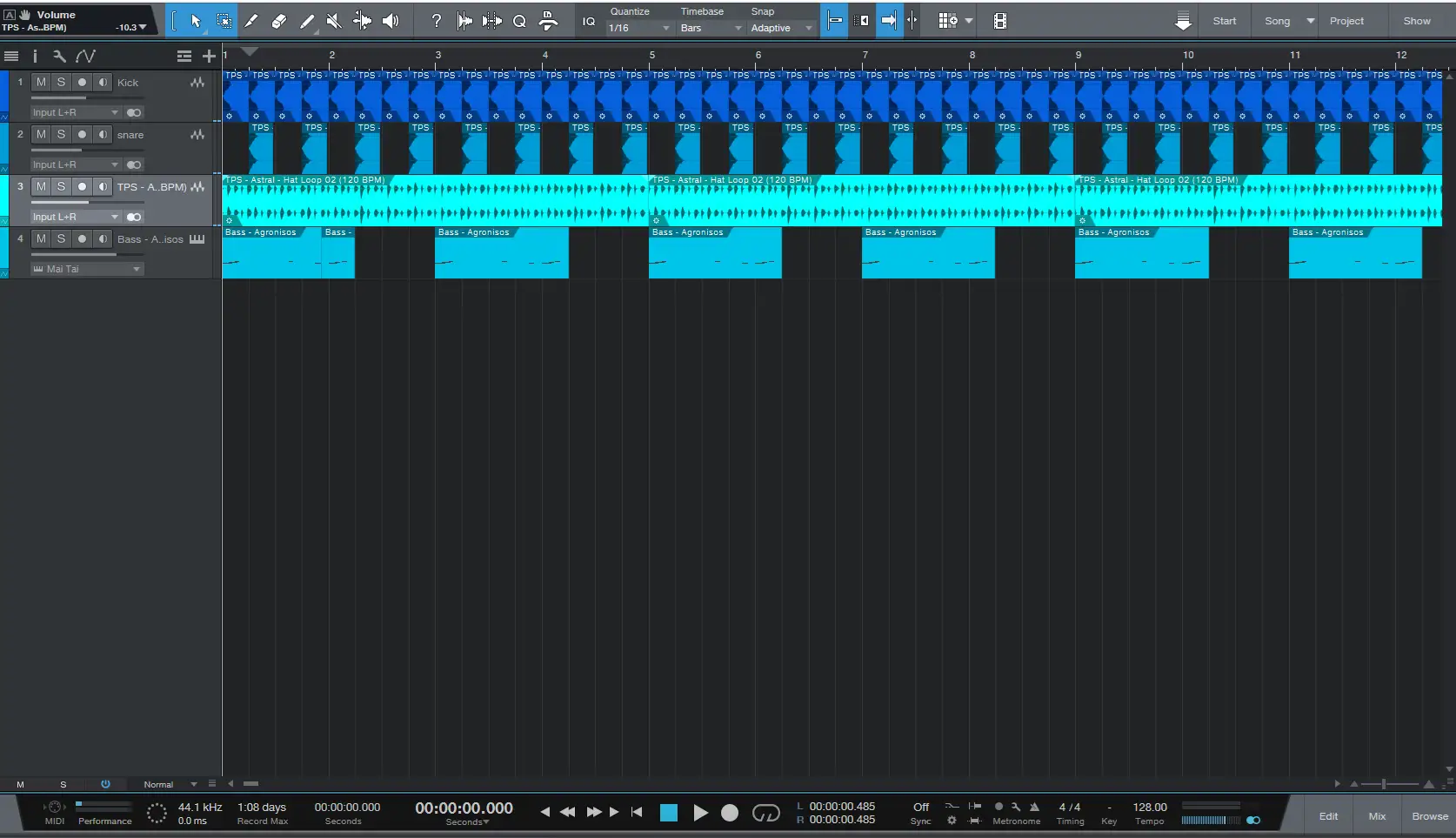
Melody and Chord Progression
Now that the foundation of your EDM track is in place, it’s time to enrich it with chords and melodies.
Once again, nothing is set in stone, but my recommendation is to focus on the following aspects, and in the order outlined below:
1) Bassline, which we already discussed
2) Chords
3) Melody
4) Vocals (if any)
In this way, you’ll create the soundscape of your song from the ground up, and chances are it’ll be easier to create a cohesive tune.
Needless to say, having a basic understanding of chord progressions and music scales will help you a great deal. EDM tracks are generally not intricate tracks from a compositional perspective, but still need to have some musicality to sound decent.
You might bring to life an iconic tune by just playing randomly on your MIDI keyboard, but understanding the relationship between different keys can help you add variety and depth to your compositions, and also make them sound more like the global hits you're trying to emulate.
For my track, I added a couple of synth melodies to enrich the sound:
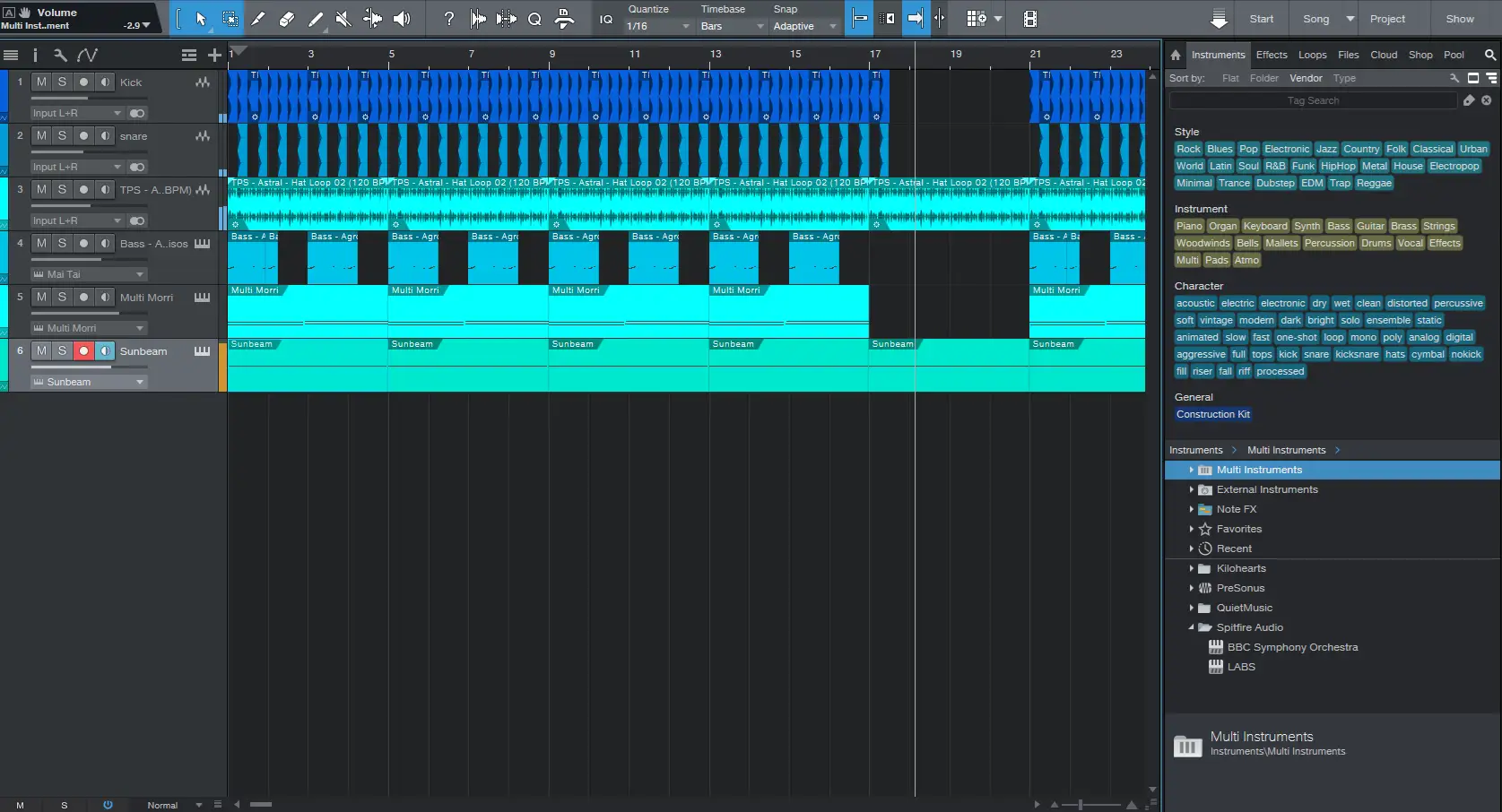
Song Structure
You might have noticed many EDM tracks follow a similar pattern when it comes to song structure.
Partly that’s because producers want to attract the listener’s attention right away with a familiar layout, but there’s another crucial factor you should consider if you want your song to be played in clubs: you need to make it “DJ-friendly”.
When mixing two tracks, DJs need time to blend the songs together before they switch to the next tune, which means songs need to start slowly, even just with the beat, and introduce the rest of the sound texture gradually.
The same goes for the song’s ending. As a rule of thumb, one minute to build the song at the beginning, and another minute to strip everything off until all that’s left is the beat, is good practice.
You can always publish two versions of the songs, as many producers do. That’s what the terms “Radio Edit” or “Extended Version” are for when you see them in a song’s title.
There are no golden rules as to what should be between the intro and outro, but there’s no doubt that build-ups and drops play a crucial role in all EDM genres.
The build-up is a crescendo: a moment of the songs where you build momentum and prepare your audience for what’s to come, which is the drop. Usually the build-up includes a drum part without the kick and some melodic parts, and exudes a feeling of expectation common in all EDM genres.
The drop is the most energetic part of a song, where there’s a sudden change in the melody, bassline or rhythm, and where the percussive elements and low-end sounds galvanize the audience.
To make the song more dynamic, you should alternate high-energy moments with quieter parts, also known as “breaks” or “breakbeats”. These are moments of the song when there’s less going on, either just the melody or the rhythm section, to add a sense of movement to the song and engage with the listener.
Layers
You saw how I created a basic structure for a song in the previous sections. That tune sounds far from complete, even though there’s a beat, a bassline, a basic melody, and all that. Why?
Once you have your song sketched out, it’s time to refine it by adding more percussive and melodic elements, mix all the elements together, add depth and texture to every sound you use.
This is where a producer’s uniqueness lies: in the ability to craft a unique sound signature, blending different elements together in a way no other music producer does.
Fine-tuning your songs before publication is fundamental and will no doubt elevate your tunes, making you sound more professional and creative.
Volume adjustments and panning play a crucial role here. Every element of your song should be heard clearly and have a specific space in the soundstage. Clashing instruments will just cause confusion and make the song unpleasant.
Listen to your song using different headphones or speakers to make sure it'll sound great on as many playback systems as possible. This process will also help you simplify the post-production process, which we'll talk about in a moment.
Plugins, Effects, Sound Libraries
Most DAWs come with a library of sounds and effects you can use to get started in the world of music production. Making sure you have the right ones for your needs, as well as learning how to use those sounds and effects in the best way possible, will be an important part of your journey as an artist.
My recommendation is to get started with what you have in your DAW. Don’t fill your library with plugins and effects you’ll never use, but rather focus on mastering the few tools you have, and then upgrade only when you feel the need to do so.
It might be tempting to download all the free libraries you can find online, but trust me, this will have a negative impact on your workflow. If you have hundreds of kick drums, you’ll end up second-guessing every decision you make as you build your beat.
Great music producers up to the early 2000s had access to a fraction of what’s available today in terms of effects and sounds, yet they could still bring to life timeless tunes. I’m not saying you should buy a reel-to-reel tape and go full-analog with your music production, but I’d recommend you reduce your library to the minimum to maximize your creative workflow.
Finalize your Track
Mixing and mastering an EDM track can be daunting at first, but when done right, these two post-production processes will enhance the beauty of your song and help you connect with your audience in the best possible way.
I won’t delve too deep into the concepts of music mixing and mastering, but I’ll explain these processes and what you should expect from each of them.
Mixing means blending every element of a song together, so that the song as a whole sounds cohesive and consistent, where all instruments have a space in the soundstage, and the result is a pleasant listening experience.
Mastering helps you reach the industry standard in terms of loudness, while enhancing certain elements of your track to make it more in line with its music genre of reference. This is the final stage of music production, where you add the final touches to your song before publication.
Unless you're producing music just for fun, both processes are fundamental if you want your songs to be appreciated and shared by your audience. While you can make your own edits and handle the post-production process by yourself, there are professional audio engineers who can make your track truly shine, so do consider hiring a mixing or mastering engineer if you want your track to succeed.
Final Thoughts
And that's all I know about electronic dance music.
I hope this guide will help you understand and explore the genre more deeply, and if these are your first steps in the world of EDM music production, I wish you the best of luck, and I hope to hear your tunes at the Ultra Music Festival!


